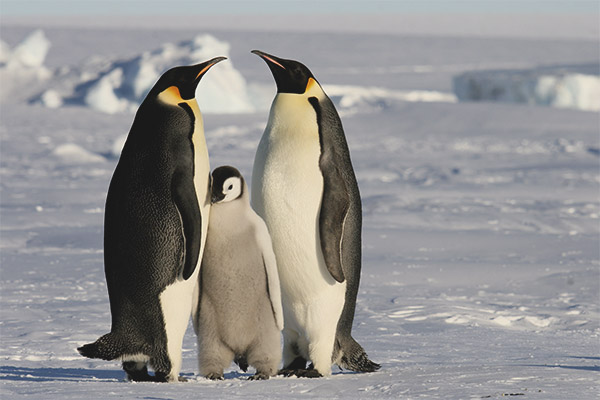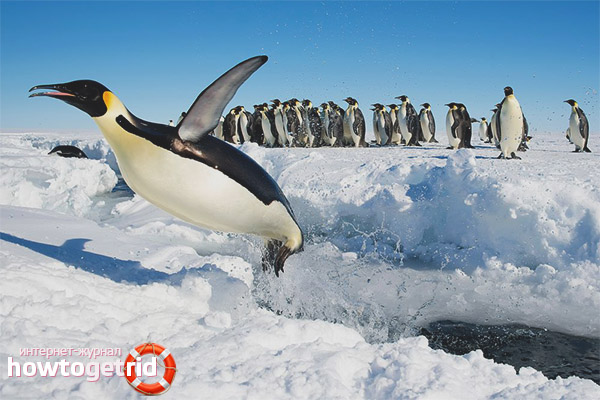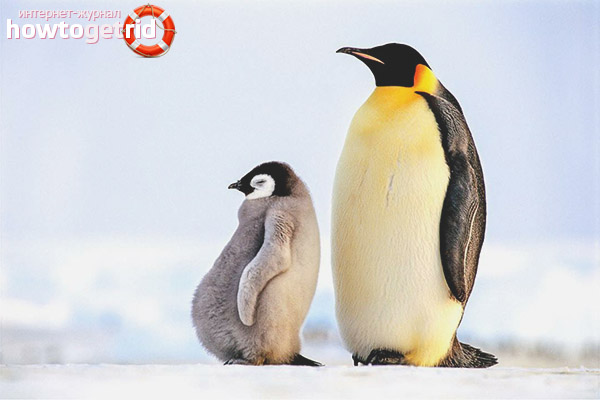The content of the article
Emperor penguins are large-sized waterfowl, which makes them stand out among all members of the penguin family.
These waterfowl birds have significant differences from other similar species - this is not only a rather large size, but also the inability of these birds to independently build nests. Hatching eggs is done through a special leathery fold-bag located on the belly (this fold is present in both males and females).
Features of appearance
The maximum size of birds is up to 130 cm in length, weight up to 50 kg. Note that this type of penguin has a large muscular mass, which is caused by a sufficiently developed nursing section of these waterfowl birds.
The color of the feather cover of the emperor penguin is black and white, this coloring helps the birds to effectively hide from their enemies in the water. The plumage under the neck and near the cheeks has a characteristic brick color. The first outfit of the big penguin chicks that have penetrated is grayish-white down. The weight of a newborn chick is no more than 320 grams. Note that the feather cover of adults provides the feathery with effective protection, preserving body heat.
Another significant difference of this species of penguins from their relatives is the density of the bones of birds (without characteristic cavities). The life span of these birds rarely exceeds 25 years in their natural habitat.
Habitat
The approximate number of representatives of this species is about 450 thousand individuals, which are divided among themselves into small colonies.Some 300 thousand representatives of the species of birds live on ice floes, however, during the breeding season and for the subsequent incubation of their offspring they migrate to the mainland.
The most numerous colony of large penguins settled for nesting on Cape Washington (at least 20-25 thousand pairs).
Behavior features
This type of waterfowl is mainly kept by small colonies, while finding places for living with natural shelters in the form of fairly large ice floes and ice hummocks. At the same time around the selected area for life necessarily present areas with open water, which, in fact, is the food supply for these birds. Often, for movement on the surface, penguins use their belly, that is, they lie on their stomach and begin to slide on the icy surface, actively helping themselves with their wings and paws.
At very low temperatures, adults gather in groups, tightly clinging to each other in order to warm up. At the same time, in such groups movement is constantly observed - the birds move, changing places.
Individuals have a very majestic look, for which they actually got their name, nevertheless, this is a very cautious bird that does not allow people to come close to itself, which is why, to this day, attempts to ring representatives of this species have not been crowned with success.
Power Features
The main ration of birds of this species is a diverse fish; for food extraction, penguins often congregate in small groups. In order to catch a fish, groups of penguins swim in floating fish schools, swallowing lingering sea inhabitants. If the prey of a large penguin becomes a large enough fish, it cuts it already on the surface.
In search of food, emperor penguins can swim quite a long distance (up to 500 km). The speed of movement of these waterfowl during the hunt is about 5-6 km / h. The duration of stay under water is about 15 minutes.
Breeding emperor penguins
The big penguins are monogamous birds, a pair created once live together for the rest of their lives.In order to attract a female - the birds of the opposite sex use their rather loud voice. The duration of marriage games is about 1 month. At this time, individuals of both sexes make quite long joint walks, but males often show their original dance in front of the females, one of the movements of which is a low bow.
There is only one egg in the clutch, which is laid by the female about a month after the beginning of the breeding season (May-June). Egg sizes are quite large (width - up to 10 mm, length - not less than 120 mm, weight - up to 500 g).
For some time, the female holds an egg in the fold of the bag, holding the latter with her wings (1.5 months), after which she passes the male for subsequent incubation, and she goes on a long hunt. For the next 9 weeks, the male emperor penguin barely moves and feeds only on snow, which is why it loses most of its weight. In the event that the penguin female does not have time to return from the hunt to the chick's chucking, the father of the family activates special glands that are responsible for processing the subcutaneous fat into a creamy composition that the male feeds to the chicks before the parent returns.
Hatching chicks are covered with down, the ability to swim they will appear after six months after the appearance of the first feather dress. After birth, young penguins can leave their parents after 1.5 months, often the result of such carelessness is their death.
Particularly noteworthy is the fact that those females who have lost their offspring can kidnap chicks and raise as their own.
Natural enemies
Often, young individuals of emperor penguins become prey for such a feathered predator, like a skua.
The main danger for the species population is global warming, besides this, there is still one factor affecting the decrease in the number of data of waterfowl birds - this is a fairly rapid reduction of the food supply.As recent studies have shown, the number of penguins in recent years can significantly decrease (to 5%). This is due to the depletion of natural resources, which is why it is becoming harder and harder for this type of bird to get the food it needs to feed. The human disturbance of their natural environment (mass development of tourism) also has a negative effect on the life of birds.
Video: emperor penguin (Aptenodytes forsteri)













To send